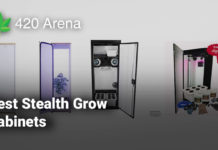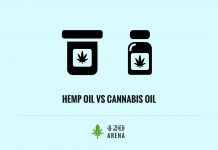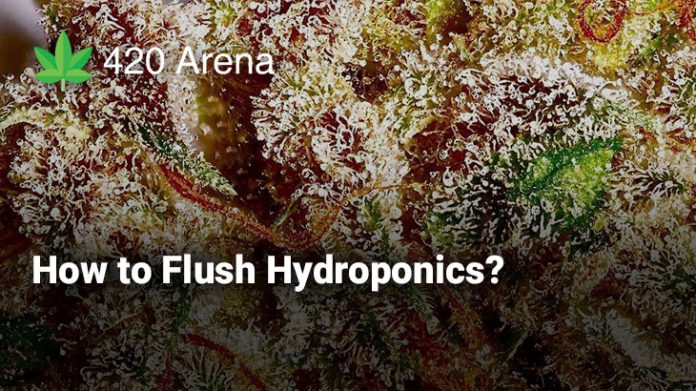Marijuana can be grown in a number of different based – however, the most common method of growing it is soil-based growth. Another popular alternative which a large number of people have been choosing of late is water-based growth, that is hydroponics! Hydroponic growth allows the plants to grow faster and offer higher returns as well. Over the course of this article, we shall take a detailed look at ‘Flushing’ which is a technique that hydroponic growers make use of in order to get their plants to grow better.
This article will talk in detail about flushing, but we will also be addressing a number of other things such as what is hydroponic growth and which is the better way of growing marijuana for you – soil-based growth vs hydroponic growth. We shall also be looking at the two different types of flushing, discuss the importance of the process of flushing before harvest – and finally, we take one last look at some of the most common and frequently asked questions about how to flush hydroponics.
Introduction to Flushing:
Just before you harvest your plants, they have to undergo a process called ‘flushing’. This process helps the plants ‘detox’ before the harvest begins. Flushing is of great importance to the plants where harvested products are actually consumed by people such as marijuana where you smoke the bud. If a plant is flushed properly, it will taste better and won’t have the residual taste of any minerals or fertilizers or any other additions that were made to the medium during the growth process.
In the simplest of words, flushing means that you are ridding the plant of unwanted minerals. It is actually quite a simple technique but timing is very important here. If you flush your plants before a specific amount of time, you might end up damaging them instead of improving them. Flushing essentially involves providing your plant with fresh water without any nutrients for a short period of time before you actually begin the harvest process. Depending on the medium as well as the size and the scale of the setup, some flushing periods last for a few days while others last for a few weeks.
Regardless of whether or not you are growing hydroponically, you still need to flush your plants. Those growing marijuana in a soil-based medium will have a larger period of flushing which can last between one to two weeks, those growing in coco coir would need about a weeklong flushing cycle, and those growing marijuana using plain hydroponics would require a few days of flushing.
Flushing in itself isn’t really complicated. However, what really makes things complex is the fact that there are two different types of flushing: first off, you need to flush the medium and secondly, there’s flushing the plants. This is where many growers might get confused. However, we will try and put out a detailed explanation for both these types of flushing and how to do it so that you will be able to clear your plants off all unwanted minerals pretty well:
How to Flush Your Plants: Flushing the Medium
One must know how to flush the medium, as well as when to flush the medium. The most simple understand of the ‘when’ part is – when the nutrients stop reaching your plant because of a nutrient lockout. To put things in an even simpler manner, when you add nutrients, bloom stimulators and other enhancement minerals to the plant, you provide them along with the water that you add to the medium. While the plant absorbs a lot of them, some minerals start building up in the medium also. The medium could be Rockwool cubes, coco coir, or even water.
One big problem that happens over time (especially with soil) is that a ‘nutrient lockout’ will take place because of the formation of the salt in the medium. The minerals get absorbed by the plants but a lot of salts remain in the soil and over time they form such a vicious layer that it will prevent the plant from absorbing any further minerals. This is basically what a lot of horticulturalists refer to as ‘salt toxicity’. Flushing the medium resolves this problem.
Those growing hydroponically in methods such as deep water culture systems need not worry too much. All they need to do is to throw away the existing nutrient solution in the reservoir and fill it with a new nutrient solution which won’t be as saturated with salts as the previous one! When you are growing using hydroponic mediums such as Rockwool cubes or coco coir, you will need to pour a solution through the medium so that any nutrients that the medium is holding on to are drained off it.
What you read above was the process of flushing the medium, which was the first type of flushing that we were talking about. Now the second type of flushing is basically the process of flushing the plant itself. Let us now take a detailed look at flushing the plants – when and how to do it.
How to Flush Your Plants: Flushing the Plants
While flushing the medium is important for the growth of the plant, flushing the plant itself is also something that every grower must know about. Given that a lot of fertilizers, nutrients and other additive substances are provided to the plants over the growing cycle, a lot of these minerals tend to build up in the tissues of the plants! Similar to how they accumulate in the medium, these minerals and mineral salts can also form in the body of the plants. Sometimes there are physical signs of this happening as well!
If these excess minerals are not flushed out of the plant’s body, they can be quite harmful for the plant as they may lead to a bad smell, physical damage or bad flavour. Growers who want to consume plant products such as fruits, flowers or buds would need to ensure that the plants are properly flushed. Ornamental plants don’t really have to worry about being flushed – but it is good if you flush them too. The biggest reason why many people grow their own weed is because they know that the product that they will be growing at home will be pure and flushing is one way to ensure that all the impurities are wiped off the plant.
The best way to flush your plant is to start providing them only with plain water a week or two before you decide to harvest them. The plant will be provided only freshwater with no additives in them – this will lead to the plants utilizing the excess minerals that they have accumulated over time. When they use all of that up, the plant gets rid of all the excesses and is ‘pure’ to harvest.
Recommended: How to Build a Hydroponic Grow Room
Frequently Asked Questions about Flushing:
1. What is Hydroponics?
In the simplest of words, hydroponic growth is a method of growing plants where the soil is not involved and water is the key element here. The roots of the plants are in direct contact with water or are surrounded by a non-soil medium such as stonewool or coco coir which allows a lot of access to water. Here, the growth is faster and better compared to soil-based growth because the plants can get direct access to water and nutrients without the roots having to look up for them. There are a number of different ways in which hydroponic systems can be set up, but the common factor among all of them is that this is primarily a water-based method of growth.
2. Can you harvest marijuana without flushing it?
The answer to ‘can you’ is yes. You can harvest marijuana without flushing it. However, the answer to ‘should you’ harvest marijuana without flushing it is a strict no. Flushing your weed is very important no matter what purpose you are growing it for – if you are growing it for a medicinal purpose then it is doubly important for you to flush it and if you are growing marijuana for consuming it for recreational purposes, then too, you must flush your weed before you harvest it so that all the excesses are drained off.
3. Why should I flush my plants?
Flushing is very important because a lot of excess minerals tend to get accumulated in the plant’s body and if they are not flushed off, they will cause a salty or a bitter taste in the leaves, fruits or buds – which is not an ideal situation for the growers. These will be ‘impure’ plants and won’t be suitable for medical consumption as well as recreational use. Hence, flushing will ensure that you are getting a clean end product.
4. What are the different types of flushings?
There are two different types of flushing:
- Flushing the Medium – this is done when the soil or the non-soil medium or the nutrient solution in which the plant is growing on has gathered an excess amount of mineral salts and the nutrients are unable to reach the plants because the salts are blocking the way. This would lead to the plant facing major nutrient shortage because nutrients are not entering them from the medium and hence a flushing of the medium is required.
- Flushing the Plant: The plant needs to be flushed because apart from the medium, nutrients can sometimes accumulate in the plant tissue as well and can lead to the taste going bad or the plant stinking, or having visible signs of damage.
5. What about organically grown plants – do they require flushing?
Organically grown plants are basically those plants where growers do not use any chemical additives but make use of microorganisms for providing nutrition to their plants. While flushing can be skipped here, but most growers do begin to provide their plants with plain water a week or so before the harvest season just to be extra cautious that the harvest is of the purest possible quality.
6. When is the best time to flush your plants?
Right before the harvest season is the best time to flush your plants. However, if you are planning to flush your medium, don’t do it unnecessarily – do it only when you feel that there’s salt toxicity and that your plants are having a hard time getting access to nutrition. Flushing the plant, on the other hand – is a standard practice that must be followed a week or two before harvest by every grower!
7. Flushing a Hydroponic Setup vs Flushing a Medium-based Setup: What is the difference?
When you flush a hydroponic setup, it simply involves draining off the existing nutrient solution completely and replacing it with a fresh nutrient solution which will be of the same composition as the previous one. However, when you are flushing a medium-based setup, then you will need to provide 4-5 times the water that you normally provide it so that all the excess mineral salts that have accumulated on these mediums such as stonewool cubes or coco coir is properly drained off. This would then lead to the plant getting proper access to nutrients that you provide it without the fear of salts blocking their way.
Recommended: How to Set up a Hydroponic Grow Closet
Conclusion
We hope that this article on how to flush hydroponics has helped you gain a better insight on understanding the process of flushing, and more importantly, how to do it. Flushing is essential for any plant which will eventually be consumed because there’s a lot at stake. The purity of the plant is very important – especially for those growers who want to consume it for medicinal purposes (or even for recreational purposes). This is something that many growers overlook and then repent! However, now that you know how to flush hydroponics, make sure that you are flushing your plants just the right way and at the right time! Do drop us a mail or let us know in the comments below if there’s anything more about this topic that you wish to know or if there is something that we might have missed out on.
Happy Growing! 🙂
Table of Contents

















![How to Use Carbon Filters in Your Grow Room [7 Best Carbon Filters for Grow Rooms in 2021] How to Use Carbon Filters in Your Grow Room](https://420arena.com/wp-content/uploads/2020/12/How-to-Use-Carbon-Filters-in-Your-Grow-Room-218x150.jpg)







![How to Make a DIY Bubble Cloner [Complete Guide] How to Make a DIY Bubble Cloner](https://420arena.com/wp-content/uploads/2021/02/How-to-Make-a-DIY-Bubble-Cloner-218x150.jpg)






[…] Read more: What is Flushing and How to Flush Hydroponics? […]